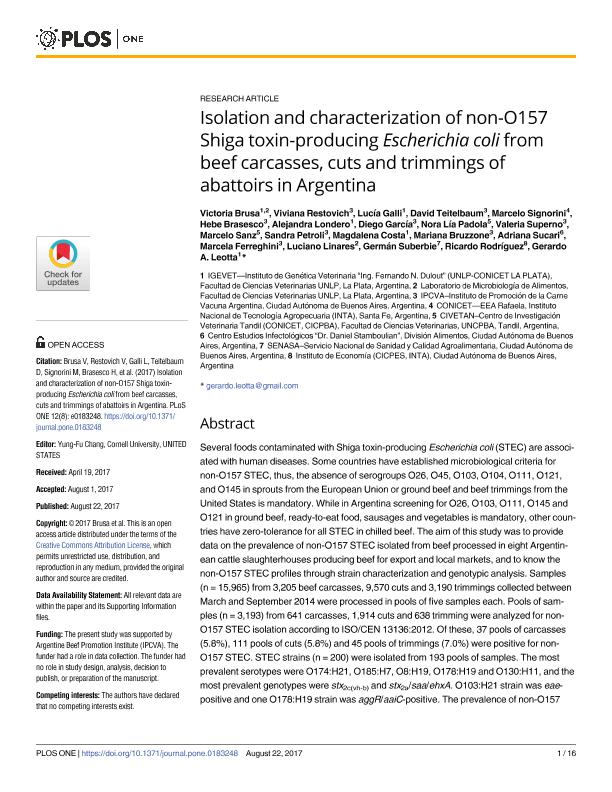Artículo
Isolation and characterization of non-O157 Shiga toxin-producing Escherichia coli from beef carcasses, cuts and trimmings of abattoirs in Argentina
Brusa, Victoria ; Restovich, Viviana; Galli, Lucía
; Restovich, Viviana; Galli, Lucía ; Teitelbaum, David; Signorini Porchietto, Marcelo Lisandro
; Teitelbaum, David; Signorini Porchietto, Marcelo Lisandro ; Brasesco, Hebe; Londero, Alejandra
; Brasesco, Hebe; Londero, Alejandra ; García, Diego; Padola, Nora Lía; Superno, Valeria; Sanz, Marcelo Eduardo; Petroli, Sandra; Costa, Magdalena
; García, Diego; Padola, Nora Lía; Superno, Valeria; Sanz, Marcelo Eduardo; Petroli, Sandra; Costa, Magdalena ; Bruzzone, Mariana; Sucari, Adriana; Ferreghini, Marcela; Linares, Luciano Hector; Suberbie, Germán; Rodríguez, Ricardo; Leotta, Gerardo Anibal
; Bruzzone, Mariana; Sucari, Adriana; Ferreghini, Marcela; Linares, Luciano Hector; Suberbie, Germán; Rodríguez, Ricardo; Leotta, Gerardo Anibal
 ; Restovich, Viviana; Galli, Lucía
; Restovich, Viviana; Galli, Lucía ; Teitelbaum, David; Signorini Porchietto, Marcelo Lisandro
; Teitelbaum, David; Signorini Porchietto, Marcelo Lisandro ; Brasesco, Hebe; Londero, Alejandra
; Brasesco, Hebe; Londero, Alejandra ; García, Diego; Padola, Nora Lía; Superno, Valeria; Sanz, Marcelo Eduardo; Petroli, Sandra; Costa, Magdalena
; García, Diego; Padola, Nora Lía; Superno, Valeria; Sanz, Marcelo Eduardo; Petroli, Sandra; Costa, Magdalena ; Bruzzone, Mariana; Sucari, Adriana; Ferreghini, Marcela; Linares, Luciano Hector; Suberbie, Germán; Rodríguez, Ricardo; Leotta, Gerardo Anibal
; Bruzzone, Mariana; Sucari, Adriana; Ferreghini, Marcela; Linares, Luciano Hector; Suberbie, Germán; Rodríguez, Ricardo; Leotta, Gerardo Anibal
Fecha de publicación:
08/2017
Editorial:
Public Library of Science
Revista:
Plos One
ISSN:
1932-6203
Idioma:
Inglés
Tipo de recurso:
Artículo publicado
Clasificación temática:
Resumen
Several foods contaminated with Shiga toxin-producing Escherichia coli (STEC) are associated with human diseases. Some countries have established microbiological criteria for non-O157 STEC, thus, the absence of serogroups O26, O45, O103, O104, O111, O121, and O145 in sprouts from the European Union or ground beef and beef trimmings from the United States is mandatory. While in Argentina screening for O26, O103, O111, O145 and O121 in ground beef, ready-to-eat food, sausages and vegetables is mandatory, other countries have zero-tolerance for all STEC in chilled beef. The aim of this study was to provide data on the prevalence of non-O157 STEC isolated from beef processed in eight Argentinean cattle slaughterhouses producing beef for export and local markets, and to know the non-O157 STEC profiles through strain characterization and genotypic analysis. Samples (n = 15,965) from 3,205 beef carcasses, 9,570 cuts and 3,190 trimmings collected between March and September 2014 were processed in pools of five samples each. Pools of samples (n = 3,193) from 641 carcasses, 1,914 cuts and 638 trimming were analyzed for non-O157 STEC isolation according to ISO/CEN 13136:2012. Of these, 37 pools of carcasses (5.8%), 111 pools of cuts (5.8%) and 45 pools of trimmings (7.0%) were positive for non-O157 STEC. STEC strains (n = 200) were isolated from 193 pools of samples. The most prevalent serotypes were O174:H21, O185:H7, O8:H19, O178:H19 and O130:H11, and the most prevalent genotypes were stx2c(vh-b) and stx2a/saa/ehxA. O103:H21 strain was eae-positive and one O178:H19 strain was aggR/aaiC-positive. The prevalence of non-O157 STEC in beef carcasses reported here was low. None of the non-O157 STEC strains isolated corresponded to the non-O157 STEC serotypes and virulence profiles isolated from human cases in Argentina in the same study period. The application of microbiological criteria for each foodstuff should be determined by risk analysis in order to have a stringent monitoring system. Likewise, zero-tolerance intervention measures should be applied in beef, together with GMP and HACCP. Further, collaborative efforts for risk assessment, management and communication are extremely important to improve the safety of foodstuffs.
Palabras clave:
Meat
,
Stec
,
Slaughterhouse
,
Quality
Archivos asociados
Licencia
Identificadores
Colecciones
Articulos(CCT - SANTA FE)
Articulos de CTRO.CIENTIFICO TECNOL.CONICET - SANTA FE
Articulos de CTRO.CIENTIFICO TECNOL.CONICET - SANTA FE
Articulos(IGEVET)
Articulos de INST.DE GENETICA VET ING FERNANDO NOEL DULOUT
Articulos de INST.DE GENETICA VET ING FERNANDO NOEL DULOUT
Citación
Brusa, Victoria; Restovich, Viviana; Galli, Lucía; Teitelbaum, David; Signorini Porchietto, Marcelo Lisandro; et al.; Isolation and characterization of non-O157 Shiga toxin-producing Escherichia coli from beef carcasses, cuts and trimmings of abattoirs in Argentina; Public Library of Science; Plos One; 12; 8; 8-2017; e0183248
Compartir
Altmétricas



